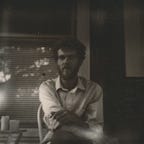Impression of Play / Our ancestors
James A. Reeves’s online quadruplex of play, by Troels Steenholdt Heiredal
I’m starting to tense up, knowing that I need to, or it’s more I want to, have to get this right. To say something profound about the work, and it’s blocking me, crippling my every move, till nothing comes out—and still I hate it all.
The concept of play has come up for me over the last few weeks, both in my readings and in conversations with friends, amongst them James A.Reeves. The idea of letting go, and give yourself space to play, for through this you will open yourself to new possibilities. Stephen King calls this writing with the door closed, in a space that is just yours, to let out anything that you might never show anyone but that it’s a process of looking through all that you entail. Not all of which will be helpful, but sometimes you have to play your way through some bad stuff to get to the really good.
Using this idea has helped me move forward with my work, to realize that I can write, draw, photograph, build anything in the act of play because afterward, I’ll always have the chance to review it.
With this in mind, I have put down my impressions of James A. Reeves’s playing with painting:
If I could only see the world through all your eyes.
One can not help to wonder about the relationship between the written word, inner vision, and the hand — when faced with James Reeves’s new painting quadruplex.
The writerly influence immediately brings to mind Stephen King’s very first rejected short story “Happy Stamps”. King describing how his mother’s tongue had turned green from licking stamps while the character in the story is described with “lips pink and eyes bleak, then slowly returns to the table” [Stephen King, On Writing, p.39]. The struggle in the craft, in the making, in the living.
In Reeves’s paintings, we find both a longing for the solitude of the wast open space, the figure and the fire — and a withdrawal into a colored interior universe. Here creatures of sampling rules, eyes giving way to eyes, with dangling claws, but no body is needed, is it hidden behind the colored background or simply been reduced, pulled into the picture plane by the force with which these were painted?
You can’t help but be drawn into this vortex behind the creatures. A masterful faint blue shadow line at the bottom makes the whole blue disc stand moving from the dark interiors of a lake to a waterfall, or is it more like a wormhole — an opening to another? A red tunnel suggests a bodily interior, from which one of these creatures emerges as a fuck’d up Jack In The Box when you sit in your most private on the toilet.
Things change in this space, where plumes become bunny ears, a classic animal of the nightmarish. Are we looking into the deserted fever dreams of a writer turn painter? As if Reeves embodies both Hunter S Thompson and Ralph Steadman at the same time.
And I can’t help but trying to put myself in the place of these creatures, what would we be able to see with that many eyes? Would get a more nuanced view of the world, or simply be overwhelmed by the multiplied impressions. Clawing for some meaning in a world the bombards us with “new” all the time, deathscrolling on Instagram, Twitter, CNN in the background, NYTimes on the table, there’s always a new — a thing we haven’t seen or liked or commented on in a snarky self-enforcing manor.
Are Reeves’s begging us to put the phone down and return to the fire, to the solitude of our beings, or our beginnings? To be still for a moment and feel our entire being, feel our hands, our eyes, the lichen forming upon our jaws, and return ourselves to the land.
And finally, it’s interesting that Reeves chooses to present this work as a quadruplex, one has to wonder if this is a nod to the softball stadium in Reeves’s former hometown of New Orleans. There’s potentially much more to unpack there, but for that, we would need a few more of Reeves’s words.
You can read James A. Reeves’s thoughts on the act of play and where these paintings did come from on his blog post here.
